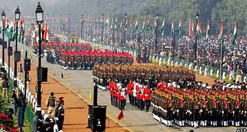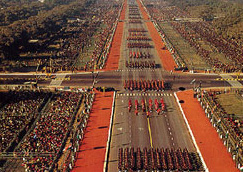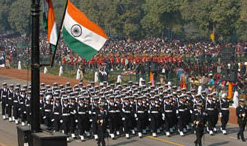On Republic Day regional identity gives way to national identity. Neither caste, creed nor religion matter. What is predominant is the Indian's of the people.

Two events are associated with India’s freedom from
colonial rule. One is Independence Day (15th August) and
the other, Republic Day (26th January). The former is a
historical even when India gained independence in 1947
and freed herself from the foreign yoke after a
protracted campaign for freedom, whereas the latter
bestowed historicity on the day when India became a
Sovereign Democratic Republic with a constitution to
guide her destiny.
Republic Day reminds us of the fulfillment of the pledge that was made on the midnight of Independence as a “tryst with destiny”. It is future-oriented, a vision of India that we nourish, an acceptance of responsibility and making of promises as well as recapitulation of the achievements. The act of framing the Constitution puts a spotlight on B.R. Ambedkar whose indefatigable labour and sharp insights helped the preparation of the document.
The difference in significance marks the variation in
the pattern of celebration of these two national days.
On Independence Day, the past is recalled whereas, on
Republic Day, the pledge is renewed. Independence Day
has rhetoric built in the celebration; Republic Day is
without speeches. It is the only ceremony in which
rhetoric is in the background and visuals are given
priority.

Republic Day is celebrated all over the country at all
the administrative units like the capital cities,
district headquarters, sub divisions, talukas, and
panchayats. The major ceremonies at Delhi and the state
capitals revolve around the parade in which all the
defence services police contingents, Home guards and
Civil Defence, NCC, school children and cultural troupes
participate followed by a display of tableaux and folk
dances.
The celebration mood lasts for one week. It consists of
the ground preparations, rehearsals, the main display
and spills over to the ‘Beating of Retreat’ on January
29, a day before Martyrs Day which marks the
assassination of Mahatma Gandhi. The mass media, All
India Radio, Doordarshan and TV channels are agog with a
variety of programmes.
The day has acquired the status of a social celebration
in which people participate whole-heartedly as
spectators. The celebration mosaic is studded with
activities. Though the parade is the main ceremony,
various activities spill over from early morning when
prabhat pheris (morning rounds) are held followed by a
homage to Gandhi. The parade is succeeded by sports
events in the afternoon. ‘At Home’ functions at the Raj
Bhavan, at the District Magistrate’s and at the SDM’s
are followed by illumination of public buildings of the
state capitals and administrative headquarters.
It is a people’s day in more senses than one. Firstly,
the constitution whose promulgation is celebrated is
highly symbolic of the aspirations which ‘we the people
of India’ cherish. It ushered in a social revolution
silently by changing the status of the individual from a
subject of a colonial empire to a citizen of a free
country. It laid down the method of governance and
established the relationship of the citizen to the
state. It endeavors to secure justice, liberty, equality
and fraternity and assures the dignity of the individual
by conferring fundamental rights upon the citizen. With
one stroke, it abolished all distinctions of status,
rank, creed, colour and sex. It outlawed untouchables,
an abominable social practice that had created
discrimination and tensions in society.

Secondly, much of the social change consequent upon the
new legislation has its roots in the Directive
Principles of State Policy. The Constitution is the
Supreme law. Hence Republic Day is sacrosanct as its
significance is deep-rooted. India at present owes its
programmes to the Constitution. She can build her future
on the basis of the tenets enshrined therein.
Thirdly, it is a day of the citizen of the country when
he is supreme. Symbolically, he can fly the national
flag on his vehicle and at the top of his house. It is a
great privilege.
Fourthly, it is a paid holiday when everyone has a right
to celebrate, enjoy, relax. No wonder the mood is
festive and recreational. Picnics are common, a movie
with a message is telecast besides the parade on Rajpath
in Delhi and the patriotic group songs with visuals.
Republic Day is gradually acquiring the celebrational
status as that of the 4th of July in USA. The
celebrations are universal, total and participatory,
children take part in a big way. Variations in culture
are displayed through colourful attires and folk dances.
The traditional predominates along with a touch of
modernity reflected in the display of might (latest
defense gadgetry and acquisitions), technology and
capabilities of growth in various sectors. The parade
symbolizes the might; the tableaux are predominated by
cultural motifs. The touch of the local highlights the
identity of the area. The celebration is thus a homage
to the past, the region and the nation that is a true
republic and imposes nothing.
|